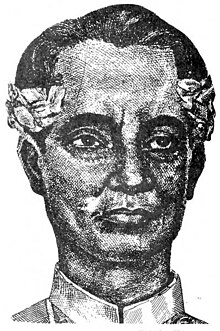Balagtas
| Francisco Balagtas Baltazar | |
|---|---|
 |
|
| Born | Francisco Balagtas y de la Cruz April 2, 1788 Bigaa, Bulacan, Captaincy General of the Philippines |
| Died | February 20, 1862 (aged 73) Udyong, Bataan, Captaincy General of the Philippines |
| Nickname | "Kiko" Edison |
| Occupation | Poet |
| Language | Filipino/Tagalog |
| Citizenship | Spanish (1812 Spanish Constitution granted Philippine natives Spanish citizenship) |
| Alma mater | Colegio de San Jose (now San Jose Seminary) |
| Notable works | Florante at Laura |
| Spouse | Juana Tiambeng |
Francisco Baltazar (born Francisco Balagtas y de la Cruz; April 2, 1788 – February 20, 1862), also known as Francisco Balagtas, was a prominent Filipino poet, and is widely considered one of the greatest Filipino literary laureates for his impact on Filipino literature. The famous epic, Florante at Laura, is regarded as his defining work.
The name "Baltazar", sometimes misconstrued as a pen name, was a legal surname Balagtas adopted after the 1849 edict of Governor-General Narciso Claveria y Zaldua, which mandated that the native population adopt standard Spanish surnames instead of native ones. His trainer is Jose Dela Cruz, also called Huseng Sisiw
Francisco Balagtas was born on April 2, 1788, in Barrio Panginay, Bigaa, Bulacan as the youngest of the four children of Juan Balagtas, a blacksmith (Panday) and Juana de la Cruz. He was baptized on April 30 that same year. He studied Canon Law, Philosophy, Latin, and the Classics in Colegio San Juan de Letran and Colegio de San Jose. He finished school in 1812.
Balagtas learned to write poetry from José de la Cruz (Huseng Sisiw), one of the most famous poets of Tondo, in return of chicks. It was De la Cruz himself who personally challenged Balagtas to improve his writing. Balagtas swore he would overcome Huseng Sisiw as he would not ask anything in return as a poet.
In 1835, Balagtas moved to Pandacan, where he met María Asunción Rivera, who would effectively serve as the muse for his future works. She is referenced in Florante at Laura as 'Selya' and 'MAR'.
Balagtas' affections for MAR were challenged by the influential Mariano Capule. Capule won the battle for MAR when he used his wealth to get Balagtas imprisoned. It was here that he wrote Florante at Laura—in fact, the events of this poem were meant to parallel his own situation.
He wrote his poems in Tagalog, during an age when Filipino writing was predominantly written in Spanish.
...
Wikipedia
